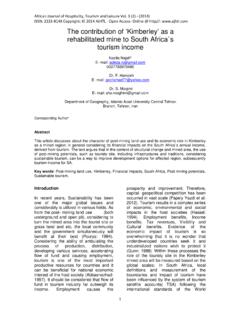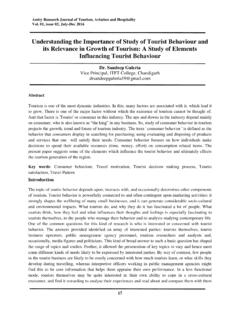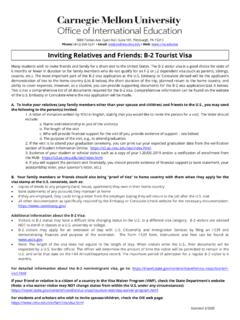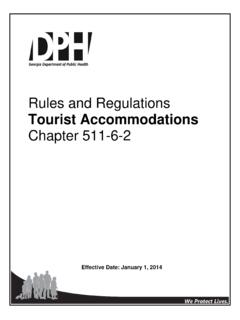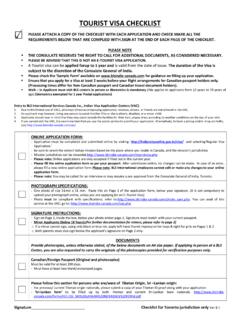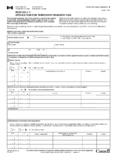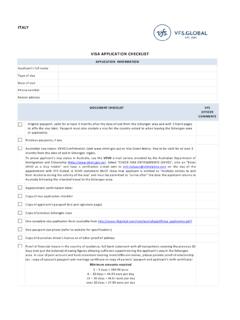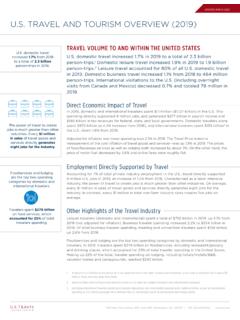Transcription of Tourist perceptions of factors influencing destination ...
1 African Journal of Hospitality, Tourism and Leisure, Volume 7 (4) - (2018) ISSN: 2223-814X Copyright: 2018 AJHTL /Author/s- Open Access- Online @ http//: 1 Tourist perceptions of factors influencing destination image: a case study of selected Kimberley resorts Rene Haarhoff Head of Department: Tourism & Event Management Central University of Technology, Free State South Africa Email: Abstract destination image is the sum of perceptual beliefs, knowledge, affective feeling, and total impression that a visitor holds about a particular destination , and it plays a critical role in determining purchase decisions in the destination -choice process, and the attractiveness of a destination .
2 In order for a destination or resort to be differentiated from its competitors, destination management must have a correlative perception and image of quality, as the consumer does. The formation of image is determined by the attributes or characteristics a destination has to offer, and by the exposition of information the Tourist receives about a destination . These factors are known as the external factors . Image formation is also influenced by personal factors like motivation, past experiences, attitudes and expectations, which are known as internal factors . Tourist destination images are important because they influence the decision- making behaviour of potential tourists.
3 A good perception leads to a positive destination image, leads Tourist satisfaction which in turn results in destination loyalty. The aim of this research was to determine whether the perception of the resorts has an influence on the visitation levels of the resorts. The resorts have reported consecutive years of low visitation and profit levels. A questionnaire was used to collect data from visitors to resorts. Unfortunately, the results indicate the visitors perceived the overall satisfaction as well the experience of staying at the resort as being average to poor. In order to ensure sustainability of the resort, it is suggested that resort management focus on improvement of resort s image.
4 Keywords: destination image, destination choice, Kimberley, resorts, Tourist perception. Introduction destination image is the sum of perceptual beliefs, knowledge, affective feeling, and total impression that a visitor holds about a destination , and it plays a critical role in determining purchase decisions in the destination -choice process, and the attractiveness of a destination (Kotler & Gertner, 2002). destination choice is determined by the attributes a destination offers, and also by the characteristics of the Tourist (Lopes, 2011). The White Paper on Development and Promotion of Tourism in the Northern Cape (NCPG, 2005) suggests that understanding tourists perceptions of a destination is of paramount importance, as they play a valuable role in the marketing of a destination .
5 Image plays an important role for destination marketers to differentiate the destination in this highly competitive market (Yilmaz, Yilmaz, D igen, Ekin, & Utku, 2009). The Tourism Master Plan for the Northern Cape Province identifies the province, and, in particular, Kimberley, as being a region which could be developed into a successful and competitive tourism destination in South Africa and in the international market space (NCDT, 2004). In order for a destination , like the Northern Cape, to be differentiated from its competitors, destination management must have a correlative perception (Zouni & Kouremenos, 2008) and image Moutinho (2000:41) of quality, as the consumer does.
6 The formation of image is determined by the attributes or characteristics a destination has to offer, and by the exposition of information the Tourist receives about a destination (Molina, Gomez, Mart n-Consuegra, 2010). These factors are known as the external factors . Image formation is also influenced by African Journal of Hospitality, Tourism and Leisure, Volume 7 (4) - (2018) ISSN: 2223-814X Copyright: 2018 AJHTL /Author/s- Open Access- Online @ http//: 2 personal factors like motivation, past experiences, attitudes and expectations (Chen, Chen, Lee, et al., 2011), which are known as internal factors (George, 2008:169). From this it can be deduced that individuals hold different images, and these images are based on individuals perceptions .
7 This research explores important concepts of (i) Tourist perception, (ii) destination image and (iii) the internal and external factors that influence destination image, and also the (iv) Tourist decision-making process. The research then gives an explanation of the relationship between these four concepts. Literature review Tourist perception Perception can be defined as the process by which an individual select, organises and interprets stimuli into a meaningful and coherent picture of the destination (Cant, Strydom, Jooste & Du Plessis, 2009:79; Jordaan & Prinsloo, 2004:177; Rajesh, 2013). Perception comprises consumers motivations, learning, attitudes, and previous experience.
8 It is subjective in nature and will therefore be different for each consumer. This, in turn, will result in the consumer attitudes towards a product and/or service provider that may fluctuate over time. Perception thus refers to the way in which consumers interpret messages via their senses in order to make a decision when buying a product. Consumers generally perceive what is expected of the product/service, which is normally based on familiarity, previous experience, values and motivations (Bajs, 2011; Baloglu & McCleary, 1999; Beerli & Martin, 2004; Cakici & Harman, 2007; Chaudhary, 2000; Henkel, Henkel, Agrusa, Agrusa & Tanner, 2006).
9 Krippendorf (1982) indicates that tourists perception of a destination can be more important than its tangible attributes, and that the Tourist goes to a destination to see the image rather than the reality . Perception remains one of the most engrossing concepts in marketing and tourism. A variety of perception studies exist in the tourism field (Bajs, 2011; Baloglu & McCleary, 1999; Beerli & Martin, 2004; Cakici & Harman, 2007; Chaudhary, 2000; Frochot & Kreziak, 2008; Henkel et al., 2006; Jenkins, 1999; Kim & Brown, 2012; Mohammed, 2014; Prebezac & Mikulic, 2008). Due to the intangible nature of tourism offerings, tourists must make decisions based on how a destination is perceived (George, 2008:169).
10 Thus, understanding Tourist perception is extremely complex, as each individual has unique perceptions and measuring perceptions is even more challenging due to the diverse characteristics of tourism products, specifically at a resort (Mohammad, 2014). Differences in perceptions often lead to variations in Tourist behavioural intent, and a key implication of this for tourism is that perceptions , like attitudes, are crucial in constructing Tourist involvement, destination image, satisfaction, and service quality (Cohen, Prayag & Moital, 2014). In order to promote tourism and market destination , it is important to study Tourist attitudes, behaviour and demands (Mohsin, 2005).




